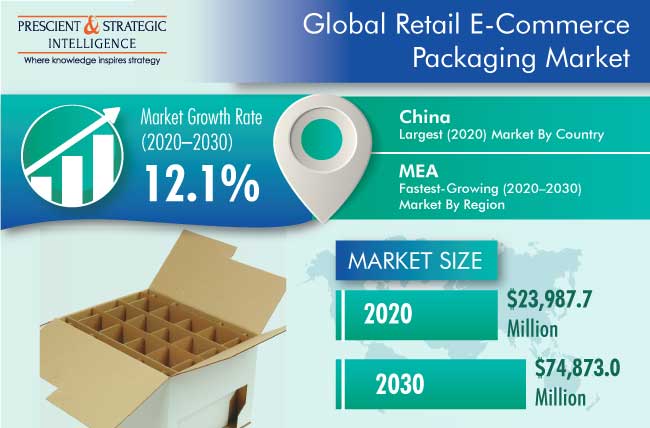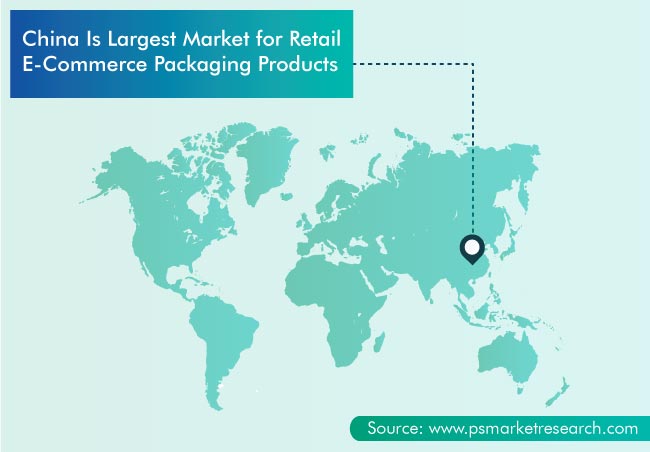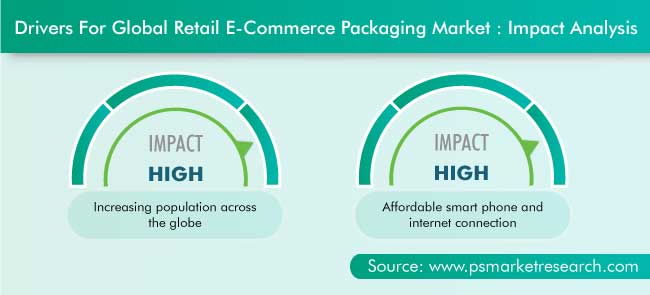Report Code: 12055 | Available Format: PDF | Pages: 162
Retail E-Commerce Packaging Market Research Report: By Material Type (Boxes, Envelopes), End User (Consumer Electronics, Fashion and Apparel, Cosmetics and Personal Care, Food and beverages, Furniture and Home Furnishing) - Global Industry Analysis and Growth Forecast to 2030
- Report Code: 12055
- Available Format: PDF
- Pages: 162
- Report Description
- Table of Contents
- Market Segmentation
- Request Free Sample
Market Overview
The global retail e-commerce packaging market stood at $23,987.7 million in 2020, which is expected to reach $74,873.0 million by 2030, demonstrating a CAGR of 12.1% during the forecast period (2020–2030). This growth can be attributed primarily to the expanding e-commerce business as a result of the increasing internet usage and changing shopping patterns.
Consumer shopping habits have changed as a result of the pandemic, specifically due to the lockdowns forcing them inside their homes. Consumers around the world are shopping more through different online channels than they did before the pandemic, thus resulting in a significant increase in e-commerce shipments and other home delivery services. This can be gauged from the fact that the pandemic has had the greatest positive influence on the food and beverage, healthcare, and e-commerce industries.

Boxes Category Dominated Market in 2020
The boxes category dominated the retail e-commerce packaging market in 2020, based on material type. The high-volume demand for products that require high-strength and durable packaging across the globe is a key factor contributing to the heavy usage of boxes among e-commerce companies, as well as consumers. Further, the increasing focus on sustainable products among e-commerce companies, in order to meet the government regulations for environment protection, is expected to drive the demand for retail packaging boxes in the future.
Consumer Electronics Category Generated Highest Revenue in 2020
The consumer electronics category generated the highest revenue in the retail e-commerce packaging market in 2020, on the basis of end user. This is attributed to the fact that e-commerce platforms provide various offers and discounts on consumer electronic products, which results in a greater number of shoppers on these sites. Further, consumers prefer to shop online as such websites offer a large number of products, with frequent discounted deals, from which they can select as per their need. In addition, the availability of customer support boosts the sale of consumer electronics via, which sometime is not available on traditional brick and mortar stores
Asia-Pacific (APAC) Held Largest Revenue Share in 2020
APAC held the largest revenue share in the global retail e-commerce packaging market in 2020, on accounts of its vast population, burgeoning e-commerce industry, and people’s propensity toward the adoption of the latest technologies. China accounted for the largest revenue share in 2020 in the APAC market. India shows the highest growth rate in the region due to its rapidly growing e-commerce industry. As per the India Brand Equity Foundation (IBEF), India is expected to surpass the U.S. to become the second-largest e-commerce market in the world by 2034, after China.

Investment by Companies to Embrace Circular Economy Is Key Trend in Market
A prominent trend identified in the retail e-commerce packaging market is investment by companies for the innovation of packaging products so that they can reduce or eliminate the waste generated during their manufacturing and reuse it as raw material. Traditionally, packaging companies discarded the leftover material after the final products were manufactured, which led to environmental pollution, but with the amendment of the laws on discarding waste materials, companies are now looking to use the leftovers in order to control the pollution and simultaneously increase their profits by reducing, reusing, and recycling.

Surging Population Biggest Driver for Market
According to the United Nations Department of Economic and Social Affairs, the world’s population of 7.7 billion in 2020 is predicted to rise to 8.6 billion in 2030, 9.8 billion in 2050, and 11.2 billion in 2100, with around 83 million people getting added each year. This is resulting in an increasing demand for both consumable and non-consumable products, which are sold through both retail locations and online outlets. Furthermore, people's rising preference for digital platforms for shopping has resulted in considerable growth of the retail e-commerce business, which is driving the retail e-commerce packaging market.
| Report Attribute | Details |
Historical Years |
2015-2020 |
Forecast Years |
2021-2030 |
Base Year (2020) Market Size |
$23,987.7 Million |
Market Size Forecast in 2030 |
$74,873 Million |
Forecast Period CAGR |
12.1% |
Report Coverage |
Market Trends, Drivers, and Restraints; Revenue Estimation and Forecast; Segmentation Analysis; Regional and Country Breakdown; Impact of COVID-19; Companies’ Strategic Developments; Company Profiling |
Market Size by Segments |
By Material Type; By End User; By Region |
Market Size of Geographies |
U.S., Canada, Germany, France, Italy, U.K., Spain, China, Japan, South, Korea, India, Brazil, Mexico, Argentina, Gulf Cooperation Council (GCC), South Africa |
Secondary Sources and References (Partial List) |
Asian Development Bank, Australian Trade and Investment Commission, China Packaging Federation, Flexible Packaging Association, Flexible Packaging Europe, Privacy Shield Framework, U.S. Department of Commerce, World Packaging Organization, World Trade Organization |
Explore more about this report - Request free sample
Market Players Involved in Mergers and Acquisitions to Gain Significant Position
The players in the market have been involved in mergers and acquisitions in order to attain a significant position. For instance:
- In June 2021, Smurfit Kappa Group plc announced the completion of the acquisition of Cartones del Pacifico SAC, a paper-based packaging company based in Peru, to expand its footprint in the Americas from 12 to 13 countries presently and become the largest supplier in LATAM.
- In March 2021, International Paper Company acquired two state-of-the-art corrugated box plants in Spain to improve its capabilities in Madrid and Catalonia, the largest industrial regions in the country. Corrugated packaging, a strategic business for International Paper in Europe, Middle East, and Africa (EMEA), offers customers high-quality packaging solutions in the industrial, fresh fruit and vegetable, and e-commerce segments.
Key Players in Retail E-Commerce Packaging Market Are:
-
DS Smith Plc
-
International Paper Company
-
Smurfit Kappa Group Plc
-
Mondi Plc
-
Packaging Corporation of America
-
Westrock Company
-
Klabin S.A.
-
Sealed Air Corporation
-
Orora Limited
-
Rengo Co. Ltd.
Market Size Breakdown by Segments
The retail e-commerce packaging market report offers comprehensive market segmentation analysis along with market estimation for the period 2015-2030.
Based on Material Type
- Boxes
- Envelopes
Based on End User
- Consumer Electronics
- Fashion and Apparel
- Cosmetics and Personal Care
- Food and beverages
- Furniture and Home Furnishing
Geographical Analysis
- North America
- U.S.
- Canada
- Europe
- Germany
- France
- U.K.
- Italy
- Spain
- Asia-Pacific (APAC)
- Japan
- China
- India
- South Korea
- Latin America (LATAM)
- Brazil
- Mexico
- Middle East and Africa (MEA)
- Gulf Cooperation Council (GCC)
- South Africa
The 2030 value of the market for retail e-commerce packaging will be $74,873.0 million.
The retail e-commerce packaging industry report is segmented on the basis of material type, end user, and region.
The market for retail e-commerce packaging was positively affected by the COVID-19 pandemic.
The retail e-commerce packaging industry is fragmented.
Players in the market for retail e-commerce packaging are engaging in mergers, acquisitions, partnerships, and collaborations.
Want a report tailored exactly to your business strategy?
Request CustomizationWant an insight-rich discussion with the report author?
Speak to AnalystOur dedication to providing the most-accurate market information has earned us verification by Dun & Bradstreet (D&B). We strive for quality checking of the highest level to enable data-driven decision making for you
Our insights into the minutest levels of the markets, including the latest trends and competitive landscape, give you all the answers you need to take your business to new heights
With 24/7 research support, we ensure that the wheels of your business never stop turning. Don’t let time stand in your way. Get all your queries answered with a simple phone call or email, as and when required
We take a cautious approach to protecting your personal and confidential information. Trust is the strongest bond that connects us and our clients, and trust we build by complying with all international and domestic data protection and privacy laws